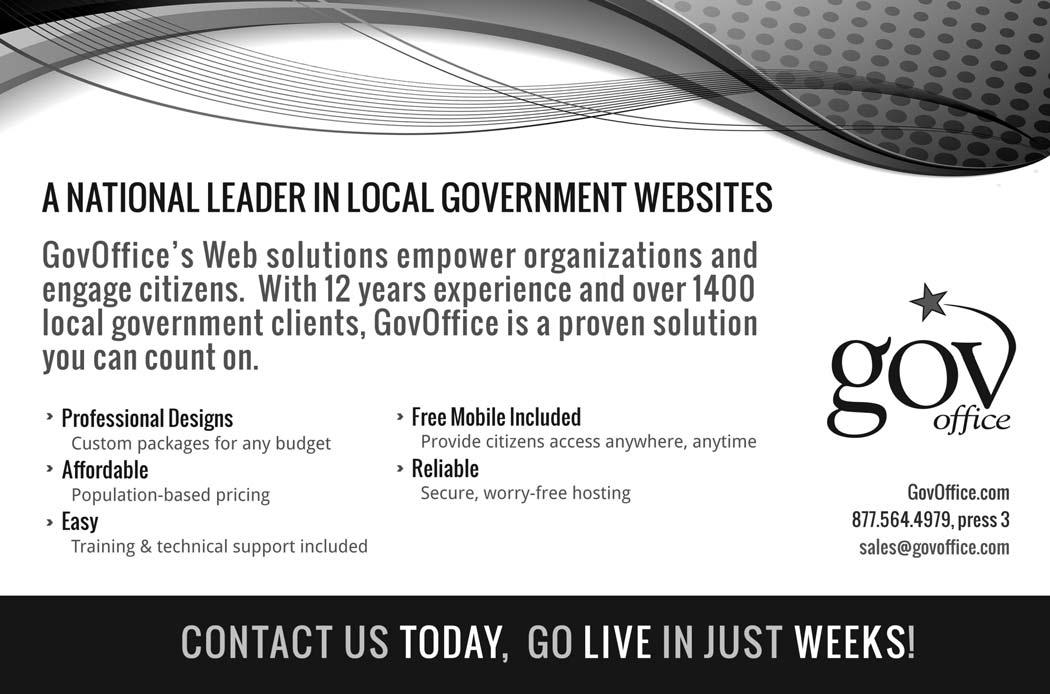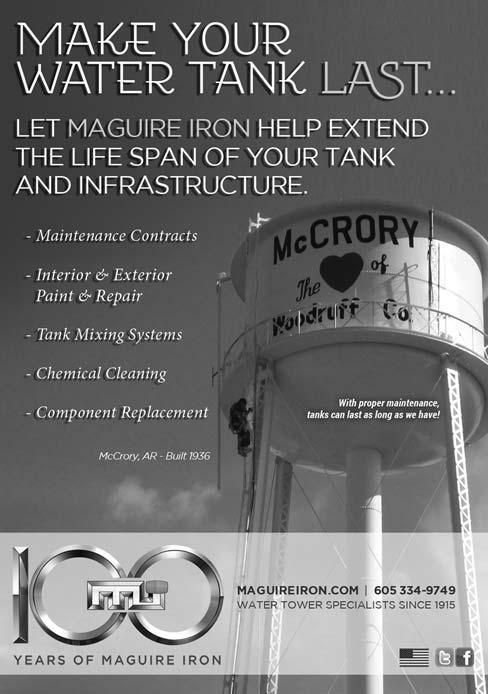
16 minute read
New Tools Available for South Dakota Communities to Improve Overall Well-being
Applications Being Accepted for Community Access Grants
PIERRE, S.D. – The South Dakota Department of Transportation is now accepting applications for its Community Access, Industrial Park and Agri-Business Grant Program.
Advertisement
The Community Access Program provides funds on a competitive basis to communities with populations under 5,000 for use in new projects involving the repair or replacement of important local roads such as the road to the elevator, to the school or hospital and in the main business district.
The Community Access applications are due to the Department of Transportation by July 17, 2017. The application deadline is intended to provide successful applicants sufficient lead-time to complete design of projects prior to the 2018 construction season. Only applications for projects that have not been constructed will be considered.
The Industrial Park and Agri-Business Grant programs provide funds to assist communities who have a new industry or agri-business and need new or expanded access to the facilities. Industrial Park and Agri-Business applications will be considered three times each year. These applications are due April 15, July 15 and Oct. 15 of each year. The applications will then be reviewed by SDDOT as well as the Governor’s Office of Economic Development before being considered at the Transportation Commission meetings.
Applications are available from: South Dakota Department of Transportation, Office of Local Government Assistance, 700 Broadway Avenue East, Pierre, SD 57501, or can be downloaded from the DOT website at: http://sddot.com/business/local/economic/Default.aspx.
If you need assistance in filling out your application, contact your local planning district or Paula Huizenga with the Office of Local Government Assistance at 605.773.6253.
For complete road construction information, visit www.safetravelusa.com/sd or dial 511.
Rural Water Q & A
Provided by the South Dakota Association of Rural Water Systems
Q: What is an illegal discharge?
A: Any time water leaves the sanitary sewer system, it is a violation of the South Dakota Sewer Discharge Permit. The Environmental Protection Agency (EPA) in Denver requires this permit. T he state of South Dakota oversees these permits with approval of the EPA.
The proper way in an emergency to discharge is in this order 1. First, protect the system from backing into homes.
2. The permit requires a call to the South Dakota Department Environment and Natural Recourses (DENR). The phone number is in the permit.
3. Take a sample. If you do not have a sample package buy a bottle of distilled water, empty it and take a sample. Remember the sample must arrive at a lab and analyzed within 24 hours.
4. Record what action was taken and why. For instance, the system had five inches of rain in three hours causing the sewer system to overflow. The duration of the discharge is a requirement of the permit. Make sure the public is aware that the water you are pumping may be contaminated and that the proper steps to protect the public. DENR is required to receive a copy of the report with an explanation of solutions that may solve the problem in the future.
DENR understands that a system cannot do anything about six inches of rain in a short period. On the other hand, smoke testing or televising the sewer system gives the regulatory and insurance company confidence that the system is trying to fix the problems that are occurring.
Q: What is a Sanitary Survey?
A: Drinking Water Program staff with Department of Environment and Natural Resources (DENR) conduct sanitary surveys of public water systems every three years. The survey is an on-site review of the water source, facilities, equipment, operations, and maintenance.
Among the main reasons and benefits of a sanitary survey is that it allows the inspector to work with the system operator to:
• evaluate and document a public water system’s ability to provide a safe and reliable water supply
• identify any deficiencies that may adversely impact the delivery of an adequate quality and quantity of safe drinking water
• identify existing and potential sanitary risks to help water systems protect public health, and
• determine compliance with drinking water regulations
Q: What would you recommend to water systems that want to develop a Wellhead Protection Plan?
A: Operations Specialists and Managers should seek technical assistance in identifying the requirements of wellhead protection and the source water assessment process. Contacting adjacent landowners to discuss the need for protection and management is also a good idea. Secondly, take the information provided by the Source Water Assessment Program and SDARWS to heart, find out what it means, realize the effects of what is around you, and act accordingly. Talk to SDARWS and DENR to get a better understanding of your water resources - or even your Water Development Districts. The EPA's 5-step process for wellhead protection planning is also another good resource.

The Future of Online Public Engagement: How to build an
By Nick Mastronardi and Alex Pedersen, for the National League of Cities
There is incredible wisdom and powerful data when civic engagement is done right. But when it’s not, we get the unfortunately all-too-familiar sequence:
● A few squeaky wheels can intimidate others at a city council or town hall meetings. ● The silent majority remains silent. ● Cities spend time and resources trying to reengage the silent majority through various communication channels. ● The fractured communication leaves citizens confused and not participating. ● The lack of participation fails to deliver officials data. ● The squeaky wheels and organized interest get their way.
Our organization, Polco, recently worked with the City of Purcellville, Va. To try a new approach to building an informed community, measuring sentiment and balancing the vocal few. Recognizing major shifts and improvement in technology, we designed a new online engagement process that’s easier and more insightful for decision makers and for constituents. Below are our findings from this partnership. We’re excited to share what we di together and how it’s working, and we’ve highlighted five critical steps the City of Purcellville took because we believe they represent best practices in engagement.
1. Define an end state and make a commitment to broad and long-term engagement that’s easy and rewarding for your community.
The City of Purcellville wanted the community to be informed on many key initiatives (and limit misinformation), feel a part of the decision making process, and wanted decision makers to have a strong pulse on community opinions and needs for these key decisions. This was not a single-issue effort. Taking this long-term and holistic approach meant that they could build engagement into more components of their daily operations and solidify it as a habit among local officials and residents.
How engagement looks from city to city may vary dramatically - some may want to engage primarily with an annual survey, others may want to poll in real time on many issues, others may want to engage primarily to message-test or for get-out-to-vote campaigns. Whatever the objective, clearly stating it and receiving buy-in from stakeholders proved critical. Interestingly, this commitment does not necessarily imply an additional time or resource burden. In many cases, developing a long term engagement plan can unify outreach channels, simplify operations, and ultimately save time.
2. Engage consistently and iteratively.
Our biggest role was to help with the “how” - the method of conducting that engagement. We thought ideally the process of engaging should be the same every time so people knew what to expect. Whether through an online forum, a dedicated Facebook page, or (in our case) on Polco, having a single consistent place to receive input from engagement creates habits among a community that keep people coming back naturally and reduces the need for outreach every time. In this case, the city posted additional policy polls about upcoming initiatives over the first few weeks of the campaign. This drew in additional members of the community and set the tone and pace for engagement into the future.
3. Reach more people for streamlined input.
With a plan in place, the next effort was to attract as much as of the community as possible. This may sound straightforward, but the idea of increasing the number of voices in a conversation can be understandably intimidating. However, with the right process to collect, verify, and organize that input, the volume can generate insight, not noise.
To reach the broadest base possible, we wanted to meet people where they already were online, let them engage there, and pipe input back to the central verifying and organizing database. This approach meant citizens could find opportunities to engage on Facebook, email newsletters, embeddable response forms, and in other ways. The list doesn’t even have to be limited to digital channels. For example, Purcellville will include a blurb and link on its upcoming utility bills. And by making sure that all of those outlets directed back to a central location online, there was no need to assemble data from various sources.
4. Report actionable and citable results.
Having the data is important, but organizing it to make it
actionable and citable was a critical next step. For instance, it’s often important to verify that those who are engaging actually live or own a property or business in your community, and collect key information such as specific location, gender or other demographics. We’ve seen this done manually through staff, or automatically using a variety of platforms. In our case, we automatically organized the results by some interesting dimensions, such as district, to help understand geographic differences within the community. With that data in hand, the City or Purcellville had a strong understanding of how the constituents felt on specific policy initiatives and could make informed decisions based on those preferences. This is engagement with impact!
5. Reward engagement with a closed loop.
At the end of the day, this input was provided by residents, and the ability to keep engagement high is likely dependent on the city’s ability to show respondents that their time had impact. We suspect the best way to do that is to communicate the outcome, and give them some closure on the issue. Regardless of whether a decision was made counter to their liking, we think closing the decisionmaking loop and explaining the outcome is critical to the long term success of any engagement campaign, so we made it easy for the city to do so.
6. What’s next?
We’ve seen great response rates from this campaign and others. Engagement is roughly 10 times that delivered by traditional methods, with nearly three percent of the population participating. But we think it’s possible to do much more. Our target is 100 times traditional methods, with the goal of regularly engaging 30 percent of the population. More participation means more informed communities on the important city issues, with a wealth of clear and actionable data for decision makers. This is what public engagement will look like in the future. If you are interested in learning more about this case study or Polco, please contact Nick Mastronardi at nick@polco.us.

About the Authors
Nick Mastronardi is the CEO and Founder of Polco, a civic engagement platform designed for local government. Prior to starting Polco, Nick served as a Senior Economist for both the President’s Council of Economic Advisers and Amazon. Nick brings policy experience, tech experience, and leadership from his time in the Air Force. Nick holds a Ph.D. in Economics from U.T. Austin and undergraduate technical degrees from the University of Notre Dame.
Alex Pedersen is the COO and Co-Founder of Polco. Prior to joining Polco, Alex servered as strategy and operations analyst for Google. Before that, he served on the Political Science Faculty at the US Air Force Academy in Colorado Springs, CO. Alex holds a BS in Operations Research from the US Air Force Academy and a Masters in Public Policy from the Harvard Kennedy School.

WOTUS to Stay at SCOTUS
By Lisa Soronen, National League of Cities
The Trump administration asked the Supreme Court to hold “in abeyance” litigation over whether a federal district court or a federal court of appeals has jurisdiction to rule whether the current 2015 Waters of the United States (WOTUS) definitional rule violates the Clean Water Act. On April 2 the Supreme Court denied the motion meaning the litigation will proceed.
President Trump’s February 28 executive order Restoring the Rule of Law, Federalism, and Economic Growth by Reviewing the "Waters of the United States" Rule calls for the “rescinding or revising” of the WOTUS rule. Many state and local governments objected to the broad nature of this rule, in particular to the expansive definition of ditches and the ambiguous definition of tributaries.
The 2015 WOTUS rule is subject to complicated litigation. In October 2015 the Sixth Circuit issued a temporary stay of the rule preventing it from going into effect nationally. In February 2016 the Sixth Circuit ruled that it, rather than a federal district court, has jurisdiction to rule on whether the WOTUS rule exceeded the Clean Water Act.

a federal district court, has jurisdiction to rule on whether the WOTUS rule exceeded the Clean Water Act. In January 2017 the Supreme Court agreed to review the Sixth Circuit ruling that an appellate court not a district In January 2017 the Supreme Court agreed to review the Sixth Circuit ruling that an appellate court not a district court has jurisdiction to rule on WOTUS. This case, National Association of Manufacturers v. Department of Defense, will not be heard until next fall 2017—meaning court has jurisdiction to rule on WOTUS. This case, National Association of Manufacturers v. Department of Defense, will not be heard until next fall 2017—meaning the Supreme Court may not issue an opinion in this case until as late as June 2018. the Supreme Court may not issue an opinion in this case until as late as June 2018. The federal government asked the litigation before the Supreme Court to be temporarily halted because the 2015 The federal government asked the litigation before the Supreme Court to be temporarily halted because the 2015 WOTUS rule may be rescinded or revised per the Executive Order meaning the Sixth Circuit’s ruling it had jurisdiction “may ultimately have little significance for the WOTUS rule may be rescinded or revised per the Executive Order meaning the Sixth Circuit’s ruling it had jurisdiction “may ultimately have little significance for the Rule that is currently under review by the court of appeals.” Rule that is currently under review by the court of appeals.” A number of parties and interveners who support the 2015 WOTUS rule objected. Conservation groups argued it is “quite unlikely that the detailed rule and technical record at issue could properly be reconsidered so quickly, and it would be inappropriate to prejudge the outcome of the deliberative process of notice-and-comment rulemaking that would apply to any such action.”
Per regular practice the Supreme Court did not explain why it denied the abeyance motion. That the motion was opposed and that the process to finalize new rules is lengthy (and hasn’t yet begun here) may have been factors. Also, the Supreme Court may be anxious to resolve the decade long confusion over federal court jurisdiction under the Clean Water Act, which would apply to future definitions of WOTUS—whatever they might be.
Visit the League’s website!
Visit the Events section frequently on the SDML website, www.sdmunicipalleague.org, to find out what meetings and trainings are coming up.
New Tools Available for South Dakota Communities to Improve Overall Well-being
Through a collaboration with the South Dakota Department of Health, Wellmark Blue Cross and Blue Shield is pleased to bring Healthy HometownSM Powered by Wellmark to South Dakotans.
The Department’s Office of Chronic Disease Prevention and Health Promotion created Good & Healthy South Dakota to provide a central source of information for South Dakota communities, schools, workplaces, childcare, health care and tribes. The Healthy Hometown program aims to engage communities of all sizes to improve the overall well-being of residents. It offers proven tools that can be used in communities to make long-lasting changes to transform the places where citizens live, work and play by making the healthy choice the easy choice.
“Have you ever noticed how your surroundings affect your activity level?” asked Elizabeth Mendelson, director of sales for Wellmark Blue Cross and Blue Shield of South Dakota. “Just think about your normal day. How often are you on your phone or tablet? Is processed food easier to fit into your hectic schedule than a healthy meal? Do you drive to the store rather than walk? Our day-to-day activities and where we live impact our health. In fact, your ZIP code may impact your health more than your genetic code.”
Expert assistance available
Communities are not alone. Assistance is available to help communities take the first step in making positive changes. Healthy Hometown experts will work with a community to help identify and prioritize goals. Strategies include implementing a complete streets policy, establishing a community or school garden or passing a nicotine-free policy in public parks. As the community works to implement its goals, Healthy Hometown experts will provide guidance in the implementation of tools where the end result has a long-term impact on the health and wellbeing of residents.
Communities interested in this free assistance can submit a Healthy Hometown Statement of Interest (SOI), available at the Good & Healthy South Dakota website. Once submitted, a Healthy Hometown representative will contact the individual who submitted the SOI to learn more about the community and ask additional questions to gauge the readiness of the community to make long-lasting changes.
Complete an online self-assessment
Any South Dakota community, worksite or school can also complete a free self-assessment and receive a report that will provide tools to help make positive changes to where citizens live, work and play. The self-assessment is available at the Good & Healthy South Dakota website. “From the self-assessment to receiving help from experts, Healthy Hometown offers something for everyone,” said Kiley Hump, chronic disease prevention and health promotion administrator for the South Dakota Department of Health. “Adopting a good and healthy lifestyle is a great way to maintain your health and prevent chronic disease. Being active, eating right, quitting tobacco use and staying educated on important health risks are all steps in the right direction. Let’s work together to make South Dakota good and healthy.”
For more information on the Healthy Hometown program, visit www.goodandhealthysd.org/healthyhometown.
SOUTH DAKOTA BASIC CODE
Affordable Codification for Small and Mid-Sized South Dakota Municipalities A comprehensive model code of ordinances for municipalities featuring: Subject matter encountered by municipalities Annual state law updates A comprehensive index and a title devoted to your unique local ordinances Published by American Legal and the South Dakota Municipal League For more information call or e-mail deRicci Getty at 1-800-445-5588 or dgetty@amlegal.com











